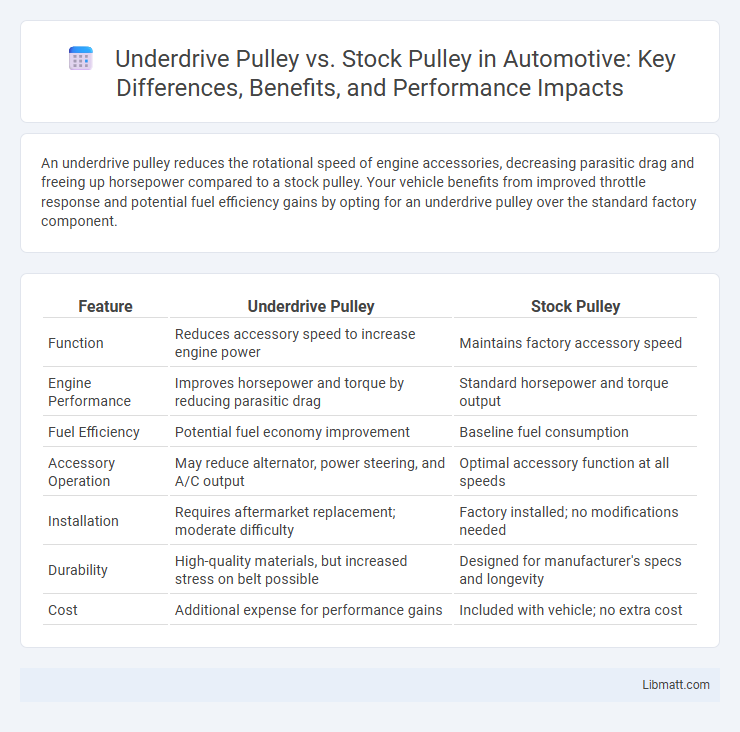An underdrive pulley reduces the rotational speed of engine accessories, decreasing parasitic drag and freeing up horsepower compared to a stock pulley. Your vehicle benefits from improved throttle response and potential fuel efficiency gains by opting for an underdrive pulley over the standard factory component.
Table of Comparison
| Feature | Underdrive Pulley | Stock Pulley |
|---|---|---|
| Function | Reduces accessory speed to increase engine power | Maintains factory accessory speed |
| Engine Performance | Improves horsepower and torque by reducing parasitic drag | Standard horsepower and torque output |
| Fuel Efficiency | Potential fuel economy improvement | Baseline fuel consumption |
| Accessory Operation | May reduce alternator, power steering, and A/C output | Optimal accessory function at all speeds |
| Installation | Requires aftermarket replacement; moderate difficulty | Factory installed; no modifications needed |
| Durability | High-quality materials, but increased stress on belt possible | Designed for manufacturer's specs and longevity |
| Cost | Additional expense for performance gains | Included with vehicle; no extra cost |
Introduction to Engine Pulleys
Engine pulleys control the rotation of various components such as the alternator, water pump, and power steering pump by transferring engine power through belts. Underdrive pulleys reduce the speed of these accessories compared to stock pulleys, resulting in decreased parasitic drag and potentially increasing horsepower and torque. Stock pulleys maintain factory-designed rotational speeds for components, balancing performance and reliability.
What is an Underdrive Pulley?
An underdrive pulley is a modified crankshaft pulley designed to reduce the rotational speed of engine accessories compared to a stock pulley, resulting in less parasitic drag and increased horsepower. By slowing down components such as the alternator, power steering pump, and air conditioning compressor, an underdrive pulley improves engine efficiency and performance. Your vehicle benefits from better throttle response and potential gains in torque by using an underdrive pulley instead of the standard stock pulley.
Understanding Stock Pulleys
Stock pulleys are designed by manufacturers to maintain optimal engine performance and reliability under standard driving conditions. They ensure balanced accessory operation, including alternator and power steering belts, contributing to smooth engine function and longevity. Understanding your stock pulley helps you decide if upgrading to an underdrive pulley aligns with your performance goals without compromising durability.
Key Differences: Underdrive vs Stock Pulley
Underdrive pulleys reduce the rotational speed of engine accessories compared to stock pulleys, leading to decreased parasitic drag and improved horsepower and torque output. Stock pulleys are designed for factory balance between performance and accessory function, maintaining standard operational speeds for components like the alternator and water pump. The key difference lies in the trade-off: underdrive pulleys enhance engine efficiency and performance but may result in reduced accessory function efficiency under specific conditions.
Performance Impact of Underdrive Pulleys
Underdrive pulleys reduce the rotational speed of engine-driven accessories, which decreases parasitic drag on the crankshaft and allows more power to reach the wheels. Compared to stock pulleys, underdrive pulleys improve throttle response and increase horsepower and torque by minimizing energy loss from components like the alternator and power steering pump. Your vehicle can experience enhanced overall performance and efficiency with a properly selected underdrive pulley.
Fuel Efficiency: Which Pulley Performs Better?
An underdrive pulley reduces the engine's accessory load, allowing the engine to run more efficiently and potentially improving fuel economy compared to a stock pulley. By spinning accessories like the alternator and power steering pump at lower speeds, it decreases parasitic drag, which can translate to better mileage for your vehicle. While the difference in fuel consumption may be modest, the underdrive pulley typically offers a measurable improvement over the factory stock pulley.
Effects on Engine Accessories and Reliability
Underdrive pulleys reduce the rotational speed of engine accessories like the alternator, power steering pump, and water pump, leading to decreased parasitic drag and potentially increased horsepower. However, this slower accessory speed can cause reduced performance in components such as charging output and cooling efficiency, potentially impacting reliability under heavy loads or extreme conditions. Stock pulleys maintain factory-designed accessory speeds, ensuring consistent and reliable operation of all engine-driven components without risking underperformance or premature wear.
Installation Process: Underdrive vs Stock Pulley
Installing an underdrive pulley typically requires removing the stock pulley, which involves loosening bolts and sometimes using a puller tool to safely detach the existing pulley from the crankshaft. The stock pulley installation is generally more straightforward since it comes pre-installed and designed to fit without special tools or adjustments. Your choice of pulley impacts installation time and complexity, with underdrive pulleys often demanding more precise handling and alignment to ensure optimal performance and longevity.
Pros and Cons of Upgrading to Underdrive Pulleys
Upgrading to underdrive pulleys reduces parasitic engine losses by slowing accessory components like the alternator and power steering pump, which can increase horsepower and improve throttle response. However, this reduction in accessory speed may lead to decreased electrical output and reduced power steering assist, especially at low RPMs, potentially affecting drivability. Your choice depends on whether you prioritize performance gains or consistent accessory functionality.
Conclusion: Choosing the Right Pulley for Your Vehicle
Choosing the right pulley for your vehicle depends on your performance goals and engine demands. An underdrive pulley reduces accessory load, improving horsepower and fuel efficiency, while a stock pulley maintains factory specifications for reliability and balanced operation. Assess your driving needs to determine if maximizing power output with an underdrive pulley or preserving original equipment performance with a stock pulley is best for your setup.
underdrive pulley vs stock pulley Infographic

 libmatt.com
libmatt.com